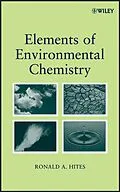The basics of environmental chemistry and a toolbox for solving
problems
Elements of Environmental Chemistry uses real-world examples to
help readers master the quantitative aspects of environmental
chemistry. Complex environmental issues are presented in simple
terms to help readers grasp the basics and solve relevant problems.
Topics covered include: steady- and non-steady-state modeling,
chemical kinetics, stratospheric ozone, photochemical smog, the
greenhouse effect, carbonate equilibria, the application of
partition coefficients, pesticides, and toxic metals. Numerous
sample problems help readers apply their skills. An interactive
textbook for students, this is also a great refresher course for
practitioners.
A solutions manual is available for Academic Adopters. Please
click the solutions manual link on the top left side of this page
to request the manual.
Autorentext
Ronald A. Hites, PhD, is a Distinguished Professor at Indiana University Bloomington, where he is a senior faculty member of the School of Public and Environmental Affairs. A past president of the American Society for Mass Spectrometry, Dr. Hites is an Associate Editor of thejournal of Environmental Science and Technology and a winner of the American Chemical Society's Award for Creative Advances in Environmental Science and Technology and of the Society of Environmental Toxicology and Chemistry's Founders Award.
Klappentext
The basics of environmental chemistry and a toolbox for solving problems
Elements of Environmental Chemistry uses real-world examples to help readers master the quantitative aspects of environmental chemistry. Complex environmental issues are presented in simple terms to help readers grasp the basics and solve relevant problems. Topics covered include: steady- and non-steady-state modeling, chemical kinetics, stratospheric ozone, photochemical smog, the greenhouse effect, carbonate equilibria, the application of partition coefficients, pesticides, and toxic metals. Numerous sample problems help readers apply their skills. An interactive textbook for students, this is also a great refresher course for practitioners.
Zusammenfassung
The basics of environmental chemistry and a toolbox for solving problems
Elements of Environmental Chemistry uses real-world examples to help readers master the quantitative aspects of environmental chemistry. Complex environmental issues are presented in simple terms to help readers grasp the basics and solve relevant problems. Topics covered include: steady- and non-steady-state modeling, chemical kinetics, stratospheric ozone, photochemical smog, the greenhouse effect, carbonate equilibria, the application of partition coefficients, pesticides, and toxic metals. Numerous sample problems help readers apply their skills. An interactive textbook for students, this is also a great refresher course for practitioners.
A solutions manual is available for Academic Adopters. Please click the solutions manual link on the top left side of this page to request the manual.
Inhalt
Chapter 1. Simple Tool Skills.
1. 1. Unit Conversions.
1. 2. Estimating.
1. 3. Ideal Gas Law.
1. 4. Stoichiometry.
1. 5. Problem Set.
Chapter 2. Mass Balance.
2. 1. Steady-State Mass Balance.
2. 1. 1. Flows, Stocks, and Residence Times.
2. 1. 2. Adding Multiple Flows.
2. 1. 3. Fluxes are Not Flows!
2. 2. Non-Steady-State Mass Balance.
2. 2. 1. Up-Going Curve.
2. 2. 2. Down-Going Curve.
2. 2. 3. Working with Real Data.
2. 2. 4. Second Order Reactions.
2. 3. Problem Set.
Chapter 3. Atmospheric Chemistry.
3. 1. Light.
3. 2. Atmospheric Structure.
3. 3. Ozone.
3. 3. 1. Introduction to Ozone.
3. 3. 2. The NO/NO2 Pathway.
3. 3. 2. The OH/OOH Pathway.
3. 3. 3. The Cl/OCl Pathway.
3. 4. Chemical Kinetics.
3. 4. 1. Pseudo Steady State Example.
3. 4. 2. Arrhenius Equation.
3. 4. 3. Chapman Reaction Kinetics.
3. 5. Smog.
3. 6. Greenhouse Effect.
3. 7. Problem Set.
Chapter 4. CO2 Equilibria.
4. 1. Pure Rain.
4. 2. Polluted Rain.
4. 3. Surface Water.
4. 4. Problem Set .
Chapter 5. Fates of Organic Compounds.
5. 1. Vapor Pressure.
5. 2. Water Solubility.
5. 3. Henry's Law Constant.
5. 4. Partition Coefficients.
5. 5. Lipophilicity.
5. 6. Fish Partition Coefficients.
5. 7. Adsorption.
5. 8. Water-Air Transfer.
5. 9. Problem Set.
Chapter 6. Toxic Environmental Compounds.
6. 1. Pesticides.
6. 1. 1. Diphenylmethane Analogues.
6. 1. 2. Hexachlorocyclohexanes.
6. 1. 3. Hexachlorocyclopentadienes.
6. 1. 4. Phosphorous Containing Insecticides.
6. 1. 4. 1. Phosphates.
6. 1. 4. 2. Phosphorothioates.
6. 1. 4. 3. Phosphorodithioates.
6. 1. 5. Carbamates .
6. 1. 6. Natural Product Simulants.
6. 1. 7. Phenoxyacetic Acids.
6. 1. 8. Nitroanilines.
6. 1. 9. Triazines.
6. 1. 10. Acetanilides.
6. 1. 11. Fungicides.
6. 2. Mercury.
6. 3. Lead.
6. 4. Problem Set.
Answers to the problem sets.
Index.
